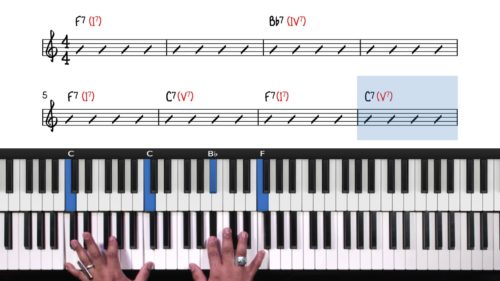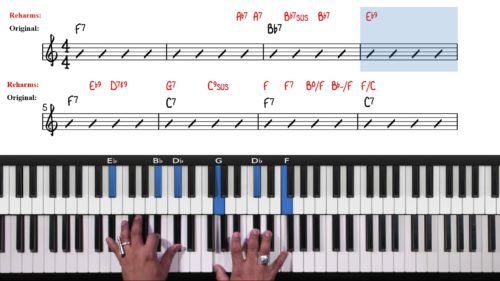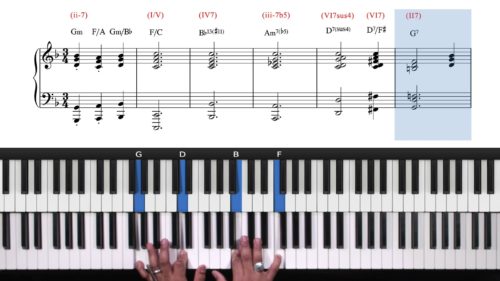Blues & Gospel Walk-Ups
In this lesson we explore blues and gospel walk-ups and how to add chromatic passing chords to our chord progressions.
We will use the F Blues Form to apply the walk-ups and passing chords but remember that you can apply these principles to any song or hymn that you are working on.
Chromatic Passing Chords From Above
We add the chromatic passing chords in the space immediately before the main chord changes in the blues. In this example we will add a B7 chord before the chord change to the Bb7 in bar 2 of the F Blues:

We can always add a chromatic passing chord a half step above any chord change to create tension and then a stronger sense of resolution.
Chromatic Passing Chords From Below
Using the same chord change, we can also approach the Bb7 with a chromatic passing chord from a half step below. Last time we approached with a B7 which is a half step above Bb7, and this time we use an A7 which is a half step below Bb7:

This relationship can be used for all of the chord changes in the blues as demonstrated in the lesson. Once you are comfortable with the concept of passing chords we can create gospel walk-ups.
Blues & Gospel Walk Ups
We can take this concept further by creating a walk up. A walk up is where we string together multiple chromatic passing chords before a chord change. Here is an example approaching the Bb7 in the F Blues:

Walk-ups can be both chromatic and diatonic. The above example is a chromatic walk-up using a string of dominant chords.
Lesson Downloads
-
Chromatic Passing Chords Notation File Type: pdf
-
Gospel Walk-Ups Notation File Type: pdf
Practice Tips
-
Chromatic passing chords are usually dominant 7 chords which are unstable chords and want to resolve somewhere.
-
First experiment with chromatic passing chords a half step above the target chord.
-
Next experiment with chromatic passing chords a half step below the target chord.
-
We can add chord extensions and alterations to our passing chords to create even more tension and a stronger sense of resolution.
-
A gospel walk-up is when we string multiple passing chords together to create a chain of chromatic dominant chords which approach the target chord.








Just the transcription of the beginning of the course would be great to learn. So beautiful.
He needs to slow down? It’s hard to cop the voicing.
Hi Glenn,
Check out this video on our video player controls – pianogroove.com/jazz-piano-lessons/video-player-controls/
In the second chapter you will see how to slow down the video to .75 .5 and .25 speed.
The video above also explains the other controls of the video player.
Let me know if I can help further and enjoy the lessons.
Cheers,
Hayden
Thx Hayden…I slowed it down to 25%. I got so much out of this lesson now.
Cheers,
Glenn :-)
Awesome, glad to hear the speed controls are helping out Glen.
Cheers,
Hayden
Hayden,
The walk ups are nice and straight forward but I’d like to learn more about the voicings he uses to make his playing sound so good, say in the first blues at 0:35. Besides the walkups, he gets a lot of variety out of the blues chords.
What’s the best course to start learning where those ideas come from? The chord extension or alterations lessons or somewhere else?
Thanks!
I agree. It woud be great if after the chord progresssion lessons he showed where the bass line and fill ins came from.
I am not sure how the section on hymn playing is used for gospel blues???
Hi Joshua,
Thanks for the feedback. I agree the demonstrations do move at a fast pace in this lesson.
Check out my course “Slow Blues For Beginners” which moves at a slower pace and I explain the fill techniques in more detail: pianogroove.com/blues-piano-lessons/slow-blues-piano-for-beginners/
Regarding the church hymns – this course is half blues-focused and half hymn-focused. If you’re just interested in gospel blues theory and technique check out the course above which I think will be more to your taste.
I also have a similar course in the key of C which is a little more advanced, you can find that here: pianogroove.com/blues-piano-lessons/slow-blues-in-c-harmony-improv/
Please let me know if I can help further, and enjoy the lessons!
Best,
Hayden